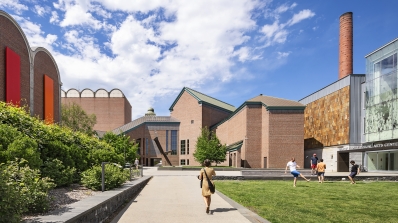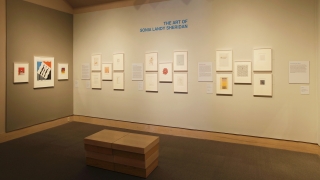Exhibitions Archive
Highlights from the Hood Museum of Art
Modern and Contemporary Art at Dartmouth
The third in a series of comprehensive exhibitions and catalogues showcasing the permanent collection, this exhibition surveys the breadth and depth of the permanent collection and highlights key works from the holdings, only a tiny fraction of which are on view in the museum's galleries at any one time. Modern and Contemporary Art at Dartmouth focuses on post-1945 painting, sculpture, works on paper, new media, and photography, and includes works by Mark Rothko, Ed Ruscha, Alice Neel, Romare Bearden, Alexander Calder, El Anatsui, Juan Munoz, Alison Saar, Amir Nour, Bob Haozous, Richard Serra, and Bill Viola, among others.
The Great Age of English Mezzotints
“The Artful Disposition of Shades"The Language of Emotion
Expression of the UnconsciousDrawing on Tradition
Contemporary Native American Ledger ArtPrints by Robert Rauschenberg
Reading ImagesRobert Rauschenberg has often been called one of the most influential American artists of the latter half of the twentieth century. He is best known for his assemblage work, in which he combined painting with found objects. While his art retained many expressionistic and painterly traits, his frequent use of materials from popular culture made him an important transitional figure between abstract expressionism and Pop Art. Rauschenberg regarded his methods as comprising a collaboration with materials rather than a conscious manipulation of them. This open-minded attitude toward art led him to experiment with a greater range of media than perhaps any other contemporary artist.
Rauschenberg's residency at Dartmouth College in 1963 marked a transitional period in his career, during which he sought alternatives to assemblage by experimenting with the printmaking process. The high level of cooperation inherent in printmaking made it especially suited to Rauschenberg, who was prone to collaborative ventures. Over the years, he worked with various printmakers and also choreographers, such as Merce Cunningham and Trisha Brown, and also arranged and performed his own pieces.
Rauschenberg's print collages incorporate both his aesthetic vision and his preoccupation with the historical, cultural, and personal layers of meaning embedded in language and images. In some cases, it helps to understand the context informing them, but this does not make their immediate aesthetic appreciation or personal interpretation any less relevant.



